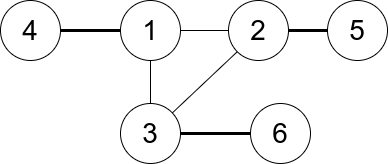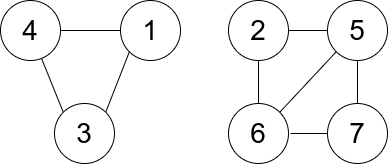- {x}
- Maximum Score From Removing Stones
- Largest Merge Of Two Strings
- Closest Subsequence Sum
- Design Most Recently Used Queue
- Recyclable and Low Fat Products
- Minimum Changes To Make Alternating Binary String
- Count Number of Homogenous Substrings
- Minimum Limit of Balls in a Bag
- Minimum Degree of a Connected Trio in a Graph
- Buildings With an Ocean View
- Longest Nice Substring
- Form Array by Concatenating Subarrays of Another Array
- Map of Highest Peak
- Tree of Coprimes
- Find the Subtasks That Did Not Execute
- Merge Strings Alternately
- Minimum Number of Operations to Move All Balls to Each Box
- Read More...

Minimum Degree of a Connected Trio in a Graph
You are given an undirected graph. You are given an integer n which is the number of nodes in the graph and an array edges, where each edges[i] = [ui, vi] indicates that there is an undirected edge between ui and vi.
A connected trio is a set of three nodes where there is an edge between every pair of them.
The degree of a connected trio is the number of edges where one endpoint is in the trio, and the other is not.
Return the minimum degree of a connected trio in the graph, or -1 if the graph has no connected trios.
Example 1:

Input: n = 6, edges = [[1,2],[1,3],[3,2],[4,1],[5,2],[3,6]] Output: 3 Explanation: There is exactly one trio, which is [1,2,3]. The edges that form its degree are bolded in the figure above.
Example 2:

Input: n = 7, edges = [[1,3],[4,1],[4,3],[2,5],[5,6],[6,7],[7,5],[2,6]] Output: 0 Explanation: There are exactly three trios: 1) [1,4,3] with degree 0. 2) [2,5,6] with degree 2. 3) [5,6,7] with degree 2.
Constraints:
2 <= n <= 400edges[i].length == 21 <= edges.length <= n * (n-1) / 21 <= ui, vi <= nui != vi- There are no repeated edges.
Minimum Degree of a Connected Trio in a Graph
This problem asks to find the minimum degree of a connected trio in an undirected graph. A connected trio is a set of three nodes where there's an edge between every pair. The degree of a connected trio is the number of edges connecting one node in the trio to a node outside the trio.
Approach
The most straightforward approach is brute force enumeration. We iterate through all possible triplets of nodes and check if they form a connected trio. If they do, we calculate the degree of the trio and update the minimum degree found so far.
-
Adjacency Matrix: We represent the graph using an adjacency matrix
g.g[i][j] = trueif there's an edge between nodesiandj, otherwisefalse. -
Degree Calculation: We also calculate the degree of each node (
deg[i]) – the number of edges connected to nodei. -
Trio Enumeration: We iterate through all possible combinations of three nodes (i, j, k) where i < j < k.
-
Trio Check: For each triplet, we verify if it's a connected trio by checking if
g[i][j],g[i][k], andg[j][k]are alltrue. -
Degree Calculation for Trio: If it's a trio, we calculate its degree as
deg[i] + deg[j] + deg[k] - 6. We subtract 6 because the three edges within the trio are counted three times each in the sum of individual node degrees. -
Minimum Degree Update: We update the minimum degree (
ans) found so far. -
Return Value: If no connected trio is found (
ansremains unchanged), we return -1; otherwise, we returnans.
Time and Space Complexity
-
Time Complexity: O(n³), where n is the number of nodes. This is due to the three nested loops iterating through all possible triplets of nodes.
-
Space Complexity: O(n²), dominated by the adjacency matrix
g.
Code Implementation (Python)
def minTrioDegree(n: int, edges: List[List[int]]) -> int:
g = [[False] * n for _ in range(n)]
deg = [0] * n
for u, v in edges:
u -= 1 # Adjust to 0-based indexing
v -= 1
g[u][v] = g[v][u] = True
deg[u] += 1
deg[v] += 1
ans = float('inf') # Initialize with positive infinity
for i in range(n):
for j in range(i + 1, n):
if g[i][j]:
for k in range(j + 1, n):
if g[i][k] and g[j][k]:
ans = min(ans, deg[i] + deg[j] + deg[k] - 6)
return -1 if ans == float('inf') else ans
The code in other languages (Java, C++, Go, TypeScript) follows the same logic with minor syntax variations. The core algorithm remains the brute-force approach described above. For significantly larger graphs, more optimized algorithms might be necessary, but for the given constraints (n ≤ 400), this brute-force solution is efficient enough.